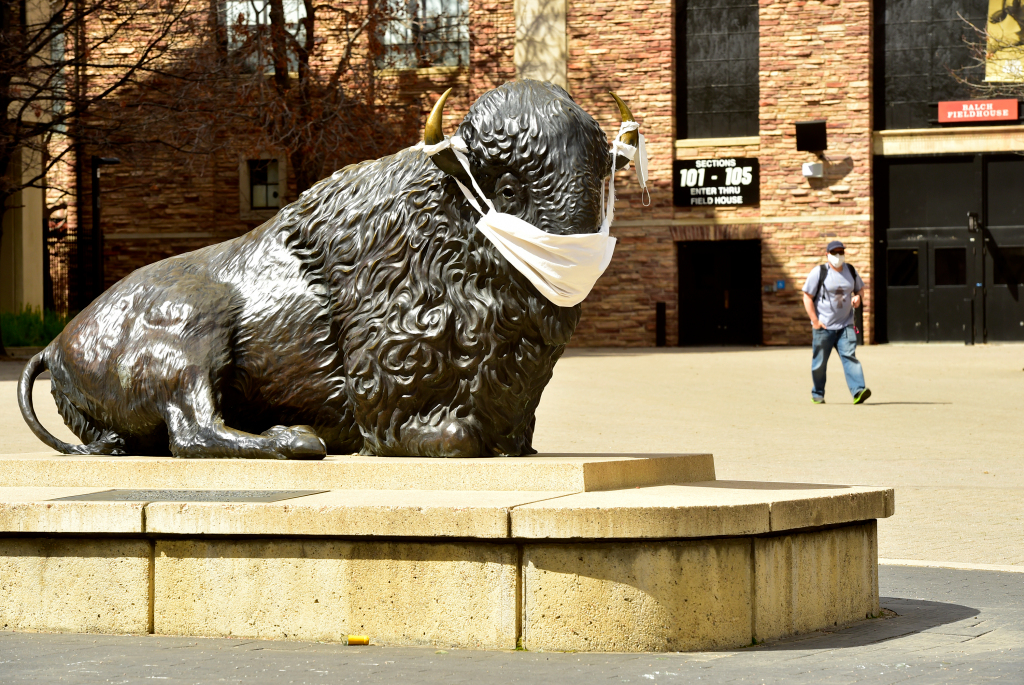The University of Colorado Boulder unveiled plans for a novel, pandemic-adjusted fall semester Tuesday, with students set to begin a mix of in-person and online classes Aug. 24 and finish up remotely after Thanksgiving, a move designed to let them head home and stay put rather than risk carrying the coronavirus back to school.
As uncertainty about classroom learning during the pandemic lingers, Coloradans’ eyes were on the largest higher education institution in the state as CU Boulder announced a series of plans and protocols to give students and staff an idea of what college life will be like when they can return, at least partially, to campus.
That will include wearing face coverings: Masks will be mandatory for students and employees, CU officials said.
The Boulder campus, which enrolled more than 35,000 students in fall 2019, aims to be less population-dense.
First-year students will be assigned on-campus housing, although details on dorm assignments weren’t yet clear Monday morning. Some students will have roommates, officials said. Freshmen who live and learn together will be placed in “small cohort groups” in a bid to reduce the spread of the virus.
Classrooms will be socially-distanced — held in larger spaces with classes split into multiple sessions. To better limit the number of people on campus at a time, classes will be spread out from 8 a.m. to 9 p.m.
The campus will have the capability to test students, faculty and staff for COVID-19, CU officials said. A rapid-response team will be responsible for tracking, notifying and isolating infected patients. Residence halls will be reserved for quarantine and isolation.
Safety training for on-campus faculty, staff and students, including instructions about physical distancing, face masks, hygiene and following public health orders, will be required.
“It is our charge as the University of Colorado Boulder to accept the call to become the most COVID-19-ready campus we can be — while building in the safety and agility necessary to minimize the risks to our community members and adapt rapidly to the uncertain dynamics we will continue to face,” the CU Boulder planning team wrote in the campus’s fall reintroduction plan, put together with the help of faculty, public health experts and community input.
CU Boulder shut down normal campus operations and initiated remote learning March 16 in response to the new coronavirus.
Tuesday marks the first steps toward a return to campus as a limited number of researchers and support staff come back to conduct research that can’t be done remotely, the university said.
Come fall, CU Boulder’s plan calls for flexibility to adapt and adhere to changing public health guidance and provide students and staff a mix of the experiences — in-person and remote, when applicable — that work best for them.
“The academic instruction section of the plan aims for a high-quality academic experience for both undergraduate and graduate students,” CU Boulder officials said in a news release. “The plan supports the development of flexible options for an in-person academic experience while meeting the needs of students and faculty whose health or personal circumstances require them to teach and learn remotely. It also provides for environmental safety in classrooms and on campus through physical distancing, class schedule adjustments and other administrative controls.”
The campus acknowledged there will be some risk involved in any model CU Boulder adopts.
“This is a moment in our history in which our imperatives to lead, innovate and impact humanity are coming together for the future of our university,” Chancellor Phil DiStefano wrote in a Tuesday letter to the campus community. “Our vision to be a leader in the humanitarian, social and technological challenges of the 21st century is embodied by all of us right now. Our success is dependent on all of us working together. Our challenge as a campus community is to ensure our mission endures. Our mission to serve the public good is more vital now than ever.”



















